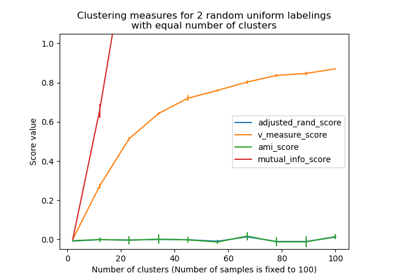sklearn.metrics.mutual_info_score¶
-
sklearn.metrics.mutual_info_score(labels_true, labels_pred, *, contingency=None)[source]¶ Mutual Information between two clusterings.
The Mutual Information is a measure of the similarity between two labels of the same data. Where \(|U_i|\) is the number of the samples in cluster \(U_i\) and \(|V_j|\) is the number of the samples in cluster \(V_j\), the Mutual Information between clusterings \(U\) and \(V\) is given as:
\[MI(U,V)=\sum_{i=1}^{|U|} \sum_{j=1}^{|V|} \frac{|U_i\cap V_j|}{N} \log\frac{N|U_i \cap V_j|}{|U_i||V_j|}\]This metric is independent of the absolute values of the labels: a permutation of the class or cluster label values won’t change the score value in any way.
This metric is furthermore symmetric: switching
label_truewithlabel_predwill return the same score value. This can be useful to measure the agreement of two independent label assignments strategies on the same dataset when the real ground truth is not known.Read more in the User Guide.
- Parameters
- labels_trueint array, shape = [n_samples]
A clustering of the data into disjoint subsets.
- labels_predint array-like of shape (n_samples,)
A clustering of the data into disjoint subsets.
- contingency{None, array, sparse matrix}, shape = [n_classes_true, n_classes_pred]
A contingency matrix given by the
contingency_matrixfunction. If value isNone, it will be computed, otherwise the given value is used, withlabels_trueandlabels_predignored.
- Returns
- mifloat
Mutual information, a non-negative value
See also
adjusted_mutual_info_scoreAdjusted against chance Mutual Information
normalized_mutual_info_scoreNormalized Mutual Information
Notes
The logarithm used is the natural logarithm (base-e).

